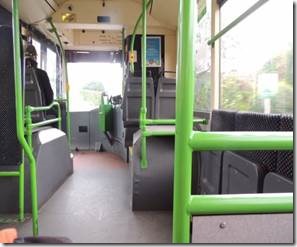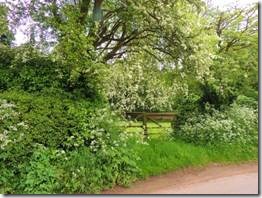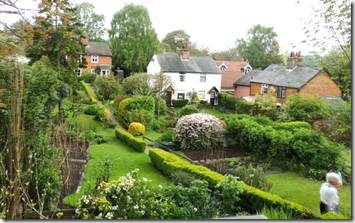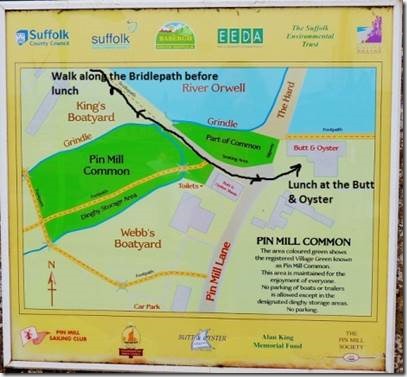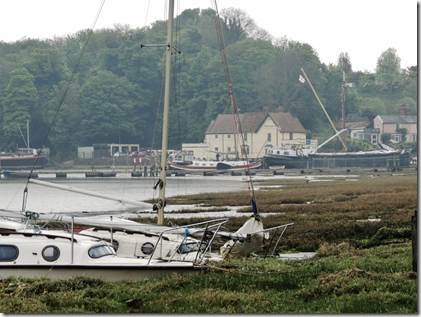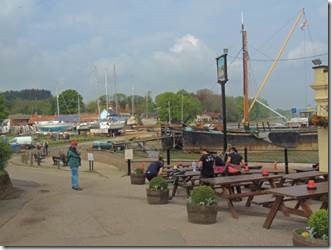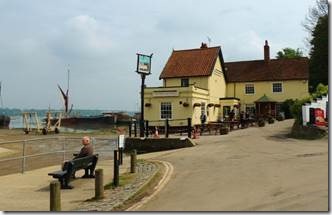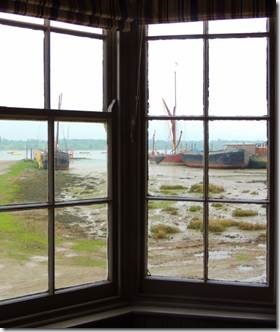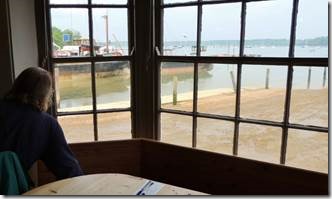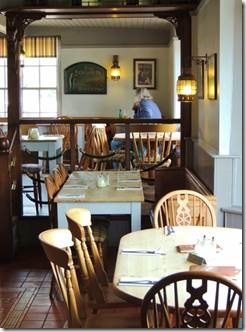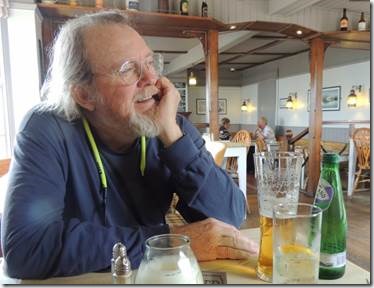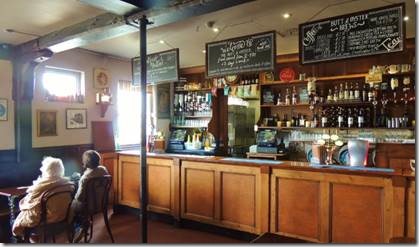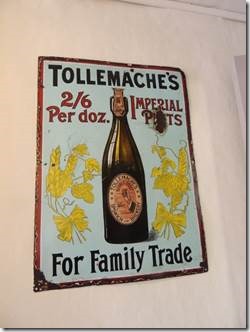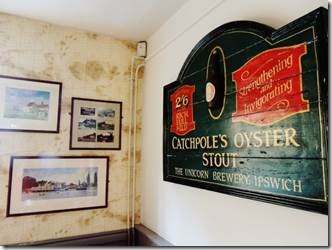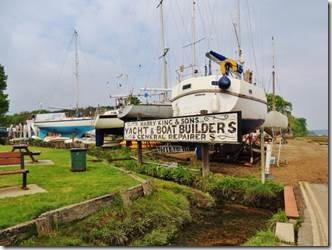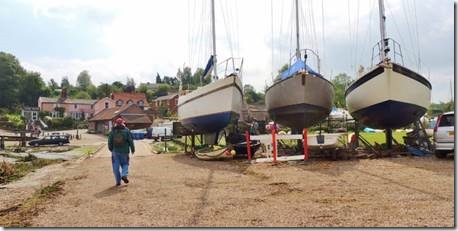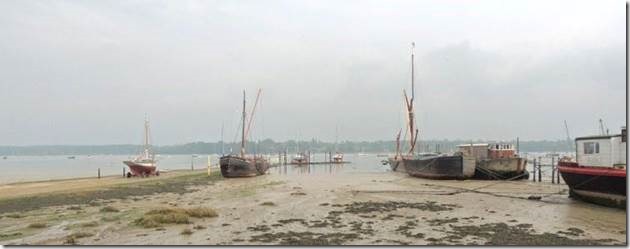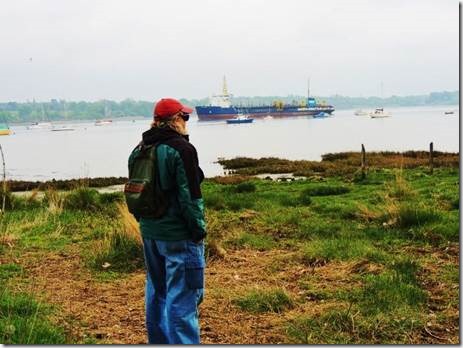Cheers,
I won’t be typing this address much longer! I’m still having to get used to the idea that “the locals” speak English and soon we’ll be moving to where they don’t. I’m going to make at least one or two more visits to the book shelves at the Charity shops to load up. I still have my Kindle but I find it’s more fun browsing for books than scrolling through Amazon. A £ 1 Charity shop paperback is usually a better read than a 99 cents Amazon download. Or so it seems.
Mary and Rick will return from Turkey this evening hopefully bringing some sunny Marmaris weather. Ipswich seems to have more rain than London. Or so it seems.
Yesterday Randal and I took the bus to Pin Mill further down the River Orwell from Ipswich. “The River Orwell flows from Ipswich to the North Sea at Felixstowe and Harwich. It is used by commercial ships bringing cargoes to and from Ipswich Docks. The channel was dredged in World War II. Until then lighters went out to big ships, anchored below Pin Mill, to take off some of the cargo so that the ships could rise and be able to sail up to Ipswich.”
Sailing barge racing: a slow boat to a past century http://www.telegraph.co.uk/ gives a bit of the history and the modern uses of those sturdy old barges. We took the bus from Chelmondiston and then walked the half mile down the road to Pin Mill Common for lunch at the Butt & Oyster. Lunch started at noon and we arrived at 11 so went off for a walk by river and fields. It was a lovely few hours and we wish we’d had more time for bus adventures.
Ru
Pin Mill on the River Orwell
|
Bus to Chelmondiston with a stop in tiny Pin Mill |
|
The single lane road from the bus stop down to Pin Mill was lovely though, popular so we had to keep a watch out for cars. |
|
“The origin of the place name is unknown. Several theories have been suggested. One is that many decades ago there was a mill in an adjoining field that made wooden pins (treenails) used in the manufacture of wooden boats. (Jonathan Webb of Webb’s boatyard still has a Trunell Mute used to hammer wooden pins into planks). Another suggestion for the place name is that a father gave the land to his daughter for Pin Money. (A dress allowance). A will of a John Crane in the 1600s mentions two pightles (small fields) at Pinneharde in Chelmondiston. Other wills mention Pynd Fold, either a pen for fish or cattle. But the derivation of the name remains vague.” http://www.pinmillsociety.org.uk/index.php/history “The river at Pin Mill must be one of the most popular subjects on the English coast for artists. A very picturesque spot worth a visit at any time of the year, Pin Mill is a small riverside hamlet at the end of a lane half a mile from the village of Chelmondiston. There are a few houses, two boatyards, an art gallery, and the ever-changing river with attendant birds constantly on the move, scurrying yachts and majestic Thames barges. Pin Mill had links to smugglers in the 19th century – these are long gone but the 17th century Butt and Oyster Inn still exists and is a thriving pub/restaurant. Arthur Ransome lived close to the ‘Butt’ and used the river as his setting for the Swallows & Amazons book ‘We didn’t mean to go to sea’. Pin Mill also featured in the popular BBC ‘Lovejoy’ series.” |
|
http://auctionpublicity.com/ shows Edward Seago’s Painting of the Butt & Oyster which recently sold for £39,650 Seago died in 1974 “The Prince of Wales, Prince Philip and the late Queen Mother were among those who admired and collected his pictures. The Prince of Wales was also a fan and once wrote: “Whatever the so-called experts may say, Ted Seago’s gifts will long be remembered, valued and loved. His work was in the best tradition of that peculiarly English school of landscape artists.” http://www.ipswichstar.co.uk/ As for John Constable or Thomas Gainsborough, I can’t find any specific connection with either artist and Pin Mill searching a very slow Internet. “The earliest building is the Butt and Oyster public house, which is mentioned in 1456 when the Water Bailiffs’ court was held there. Inquests were also held in the pub, as many instances of drowning occurred in river accidents.” |
|
Randal day-dreaming of a house in Virginia…. |
|
The best thing about good pubs is that you see men and women of all ages. Familiar brewery names from Ipswich history : Tollemache and Catchpole |
|
“Yachting was a popular recreational activity and William Garrard started a boat building business c1850. Harry King was apprenticed to Garrard and in 1896 Harry took over the business. The Harry King and Sons sign near Pin Mill Common is well over 100 years old. The Kings built and repaired many wooden boats and during both wars built life rafts and dinghies for the Royal Navy. The old boatshed is long gone, but many well-known yachts were built there including Selina King for Arthur Ransome, who featured Pin Mill in his 1937 book, ‘We did not Mean to go to Sea.’ Norman and Sam King took over the business from their father and Sam’s son Geoff carried on until 2006, when he passed the business on to Gus Curtis and his wife Sarah.” |
|
Looking into Butterman’s Bay of the River Orwell and the old time sailing barges |
|
Big ship going up to Ipswich now that the river has been dredged. |

